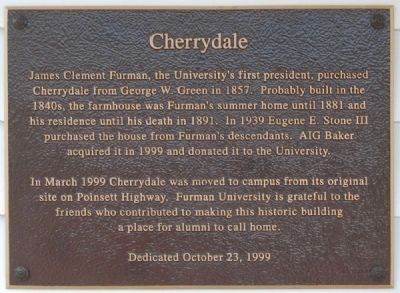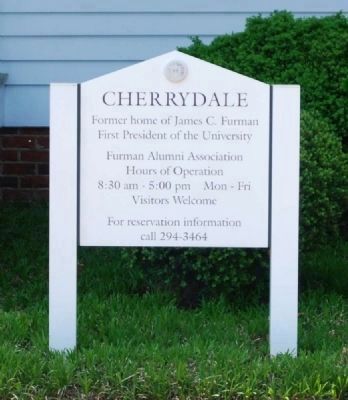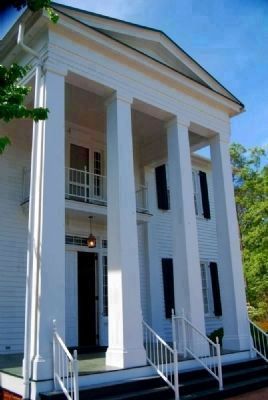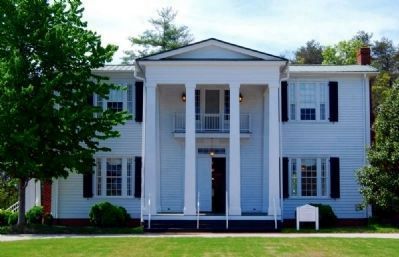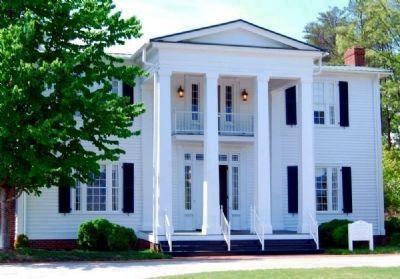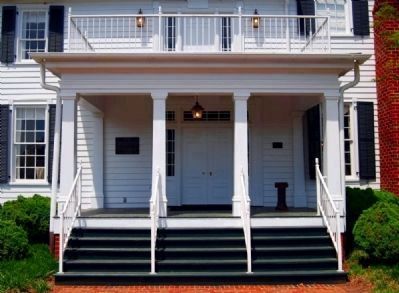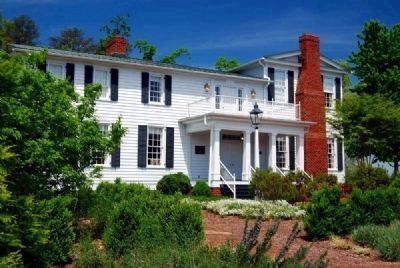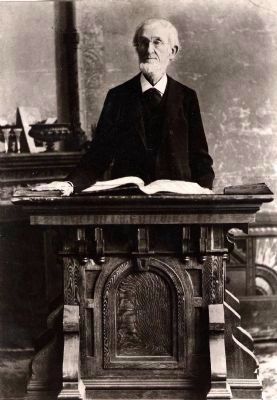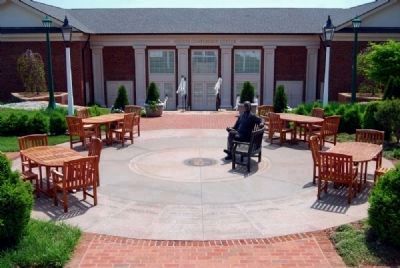Greenville in Greenville County, South Carolina — The American South (South Atlantic)
Cherrydale
In March 1999 Cherrydale was moved to campus from its original site on Poinsett Highway. Furman University is grateful to the friends who contributed to making this historic building a place for alumni to call home.
Erected 1999.
Topics. This historical marker is listed in this topic list: Education. A significant historical month for this entry is March 1999.
Location. 34° 55.05′ N, 82° 26.433′ W. Marker is in Greenville, South Carolina, in Greenville County. Marker can be reached from Cherrydale Road. Marker is located on the south facade of the building. Touch for map. Marker is in this post office area: Greenville SC 29617, United States of America. Touch for directions.
Other nearby markers. At least 10 other markers are within walking distance of this marker. DeSantis Pavilion (within shouting distance of this marker); Melvin and Dollie Younts Conference Center (about 300 feet away, measured in a direct line); Furman University World War II Memorial (approx. 0.2 miles away); Furman Men Who Gave Their Lives in the World War (approx. ¼ mile away); Herman W. Lay Physical Activities Center (approx. ¼ mile away); Eugene E. Stone III Soccer Stadium (approx. 0.3 miles away); Poteat Hall (approx. 0.3 miles away); Geer Hall (approx. 0.3 miles away); Marshall E. and Vera Lea Rinker Hall (approx. 0.4 miles away); Herman N. Hipp Hall (approx. 0.4 miles away). Touch for a list and map of all markers in Greenville.
Also see . . .
1. Cherrydale. Cherrydale is significant both as an example of Greek Revival architecture and as the home of James Clement Furman, a Baptist preacher active in educational and political affairs in South Carolina during the mid-nineteenth century. (Removed from the National Register December 8, 2005.) (Submitted on April 26, 2009, by Brian Scott of Anderson, South Carolina.)
2. Biography of Richard Furman. Clergyman, patriot, educator, and pioneer denominational stateman. (Submitted on April 26, 2009, by Brian Scott of Anderson, South Carolina.)
Additional commentary.
1. Cherrydale - National Register Nomination Form
Cherrydale
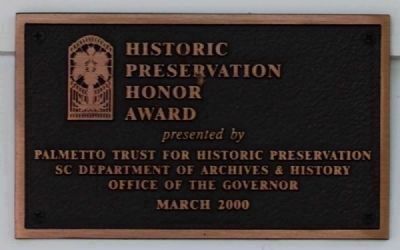
Photographed By Brian Scott, April 25, 2009
2. 2000 South Carolina Historic Preservation Award
On March 7-8, 1999, Furman University moved the 1850 home of its first president to a new site four miles from its original location. The property on which the Greek revival mansion stood had been sold, and the house was faced with certain demolition to make way for a shopping center. The developer offered the house to Furman University on the condition that it be moved to a new location. As the home of James Clement Furman, the house had great historical significance for Furman University. The move took two days and more than $500,000. A site was prepared at the highest point on the Furman campus, where Cherrydale is the University’s new alumni house.
The actual construction date for Cherrydale is not known although it is traditionally believed that the house was built in the 1840s by George Washington Green. In 1857 James Furman bought the property from Green and lived at Cherrydale until his death in 1891. The present owners acquired Cherrydale from the Furman heirs in 1939.
Exterior: The front facade of this two-story frame structure features four 9/9 Palladian derived windows and a three bay entrance porch. Placed on a low foundation, the four, square, porch columns rise two stories to a low-pitched pediment. Columns display unusual entasis. The front door is framed by side-lights and fanlight -- a door treatment that is repeated in the entrance to the second floor balcony directly above.
The forward portion of the left facade features an exterior chimney rising between four 9/9 lights. The left facade continues to the rear in a wing with two 9/9 lights and one 6 light window on the first floor and three 9/6 lights on the second floor. A three-bay, one-story side porch with square columns extends from this facade. Above the porch a window has been converted into an exhaust fan unit. The low-pitched roof of this wing is broken by a single interior chimney.
Rear facade reveals certain alterations that have been necessary to adapt structure to contemporary living -- these include the enclosure of a rear porch and the addition of two bathrooms. (Alterations were done after acquisition by present owners in 1939.)
Cherrydale's right facade features an exterior chimney rising between four 9/9 lights. Right facade is characterized by recessed wing.
Interior: Wide entrance hall flanked by two rooms. Identical mantels in both rooms. Similar mantels in upstairs bedrooms. First floor has 5 rooms plus bath and storage room. Second floor has 4 rooms plus bath. Pine floors and hand-blown window panes characterize structure.
Architecture: Cherrydale illustrates the popularity of the Greek revival architectural influence of the first half of the 19th Century. The sense of balance and proportion of the facade, the lines of the three-bay portico, and the unusual entasis are all noteworthy features of the structure.
Education/Religion: James Clement Furman served as head of Furman (University) from 1852-1879. During the War Between the States, the school closed and Furman taught at the Greenville Female Academy. When the college reopened in 1866, Furman took over as president and remained to teach and to preach. He also served as associate editor of the Baptist Courier. (Named in honor of James Clement Furman's father, Furman University is today a Baptist affiliated co-educational institution with an enrollment of approximately 2,100 students.)
Political: Early in 1860 unionist sentiment was still prevalent in the Greenville district of South Carolina. James Furman opposed this and encouraged fellow citizens to support secession. When delegates were selected for what was later to be known as the Secession Convention of 1860, the secessionist ticket of which Furman was a part overwhelmingly defeated the unionist ticket headed by Benjamin F. Perry, noted Greenville lawyer and editor. Furman served as one of Greenville District's representatives at the Secession Convention of 1860 -- a convention which unanimously adopted the Ordinance of Secession.
— Submitted June 30, 2009, by Brian Scott of Anderson, South Carolina.
2. James Clement Furman
Born in Charleston, James Furman’s legacy is the service and devotion he gave to his namesake university, which is actually named for his father, Dr. Richard Furman, a Baptist minister and denominational leader. The junior Furman began his tenure as a member of the Furman University faculty while it was still located north of Columbia in Fairfield. He would, working with members of the school’s board of trustees, campaign over the next six years to persuade the state Baptist Convention to move the school to Greenville, where it eventually opened in 1851 in McBee Hall. He would go on to become chairman of the faculty and later president of the university.
Furman, an ardent states’ rights supporter, was heavily involved in politics, as well. In 1860, he secured an appointment as one of the Greenville delegates to attend the Secession Convention, a meeting that would eventually lead South Carolina to become the first Southern state to secede from the Union. On December 20, 1860, Furman was one of the signers of the Ordinance of Secession. (Source: G: The Magazine of Greenville, Jan/Feb 09 pg 70.)
— Submitted April 25, 2009, by Brian Scott of Anderson, South Carolina.
3. James Clement Furman: History in Brief
At a Glance James Furman became an influential political figure in the community and a leader at Furman University, a school that his father, Dr. Richard Furman, worked to found.
Claim to Fame Furman is best known for his efforts to have Furman University moved from Fairfield, South Carolina, to Greenville in 1851, where it opened in McBee Hall on the corner of Main Street and McBee Avenue. He was chairman of the faculty before later becoming president.
Did You Know? Furman University closed during the Civil War, so Furman became president of the Greenville Women’s College instead. Initial efforts to reopen the school after the war’s conclusion were unsuccessful, but Furman was quoted as saying, “I have resolved, if the university should go down, to sink with it.”
An Impressive Eulogy At an 1870 commemoration of the death of Confederate General Robert E. Lee, Furman was a featured speaker. (Source: G: The Magazine of Greenville, Jan/Feb 09, pg 70.)
— Submitted April 25, 2009, by Brian Scott of Anderson, South Carolina.
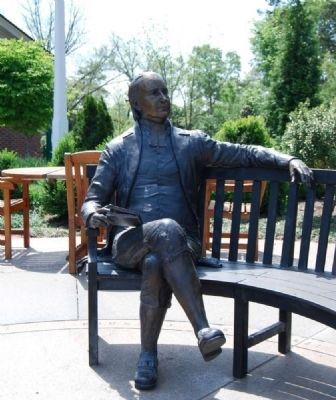
Photographed By Brian Scott, April 25, 2009
9. Dr. Richard Furman
October 9, 1755 - August 25, 1825
Father of James Clement Furman
October 9, 1755 - August 25, 1825
Father of James Clement Furman
Born in Esopus, N.Y., died in South Carolina. Clergyman, patriot, educator, and pioneer denominational stateman. More than any other man, he created the basic organizational concepts that are unique in Southern Baptist denominational life.
Credits. This page was last revised on November 16, 2020. It was originally submitted on April 25, 2009, by Brian Scott of Anderson, South Carolina. This page has been viewed 1,343 times since then and 43 times this year. Photos: 1, 2, 3, 4, 5, 6, 7, 8, 9. submitted on April 25, 2009, by Brian Scott of Anderson, South Carolina. 10. submitted on July 27, 2009, by Brian Scott of Anderson, South Carolina. 11. submitted on April 25, 2009, by Brian Scott of Anderson, South Carolina.
